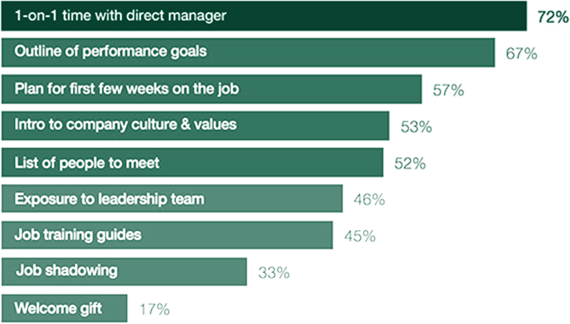Onboarding new employees is a critical task for any business. It is important to get people up to speed on the company’s culture, policies, and procedures quickly in order to ensure employee success. Yet many businesses don’t know what onboarding means or how they can do it well. This blog post will give you some strategies that you can use when onboarding your newest hires so that you are able to help them be successful sooner!
We have all been there and survived a new role, a new team, or a new business. For some it was difficult, navigating new cultures, politics, teams, and new bosses.
For others, it was a breeze and you felt supported at every step along the way.
Lucky you, as this is a good example of when businesses get it right.
It’s not that when you hire someone you plan to get it wrong, but sometimes we just don’t have the time or something goes wrong on the day our new employee turns up and your attention is diverted. Sound familiar?
It is so often that we hear managers say that they don’t have time and well quite frankly people need to work it out for themselves, they need to sink or swim. You paid enough in recruitment fees, right? They should be able to do the job and if not we will simply get another one. Now imagine that your business has just purchased a new computer program that is taking time to sink with your processes and as a result, it is slowing down production and causing stress for the teams.
How long do you think management would take to make this a priority? One week, one month, or maybe six months?
You see this occurs because individuals are all so different and hiring new people is not a simple task. It is difficult to predict the success or failure of new hires, particularly those that are in leadership roles.
Like the example above when we talk about a computer program or even a piece of equipment, we almost defiantly say that management would make it a priority to fix the issue so as it doesn’t cause any more delays to production and stress to co-workers.
Shouldn’t we say the same must be true for our new hires?
We should want to make onboarding a priority because it will help ensure employee success. It is important that you need to know who this person is before they walk through the door, what are their values and how do they handle situations? You have to understand your people so well that you can predict what they will do before it happens.
You need to know your employee’s strengths so you can put them in the right role and give them opportunities, but also realize their weaknesses so that their development needs are clear and you have an opportunity to address this early on. This is particularly important if new hires come into leadership roles as these individuals can set the tone for employee engagement, productivity and motivation.
Onboarding is not a one-time event but rather it’s an ongoing process that needs to be tweaked, adjusted and improved as your new employee grows and becomes more acclimated with your company culture.
Now let’s take a look at what onboarding actually is.
Onboarding is a process that helps new employees become acclimated to your business and culture. It occurs in three phases: employee engagement, employee development, and employee retention. In each phase of onboarding there are specific considerations you need to be aware of in order for the program to succeed.
What does good onboarding impact?
There are many studies that all report on the same statistics when it comes to onboarding new employees and how effective programs not only make for a great impression but can also save you money and time.
That’s right, good programs save time, and you get better outcomes.
According to Bersin by Deloitte, the average cost per hire is almost $4,000, this depends on the roles you are hiring for.
Furthermore, 69% of new hires are more likely to remain with your company for up to three years when a well-structured onboarding program is in place.
A study by O.C Tanner reported that 20% of turnover happens in the first 45 days. If this is even slightly true at an average cost of $4000 per person to hire it is a lot of money wasted and time hiring new employees that could have been used elsewhere, not to mention the productivity losses by having the role unfilled.
What does an effective program look like?
A recent study conducted by LinkedIn surveyed 14,000 global professionals showed what new hires want in their onboarding.

Forbes Human Resources Council has extensive research and talks about the importance of onboarding in their article, “Second impressions the impact of effective onboarding”.
How can ChandlerWoods help?
At ChandlerWoods, we are not only passionate about finding you top talent but also helping you to retain and grow your talent.
We recognise the investment you make when hiring new people and we also understand the issues with time you have as a leader. We have been there as leaders ourselves and made the same mistakes which are why we have developed our Leadership Effectiveness Program that has delivered great results for our clients in hiring both new hires and promoting from within.
The Leadership Effectiveness Program
The program has been designed to help busy managers onboard new employees. The program has 5 modules that start as soon as your new hire signs their contract. Acting as a coach that facilitates the program between the manager and new employee the modules cover the following:
Before you start – Before you start in your new role it is important that you spend some time in preparation to set yourself up for success. By the end of this section, you will understand your key strengths and how they will help you succeed in your new position.
Ready Set Go – It’s your first day and making impressions is important. What you do and say on your first day and first two weeks matters in developing trust and solid relationships.
30 days and running – This module will concentrate on taking you through to the end of your first 30 days on the job and will focus on the key tasks and priorities you should achieve.
60 days, who’s your team? – Month two on the job is about consolidating the facts with hard data and gaining feedback and insights from your key stakeholders.
90 days, what’s your plan? – You’re now heading into your third month on the job and it’s time to deliver your forward plan with the confidence and capability you were hired for.
The modules guide new leaders through practical work-based activities and tools. Managers are supported with checklists and tools to ensure they lead the way.
Contact us today to discover how we can help your organisation succeed through quality talent and people management.
